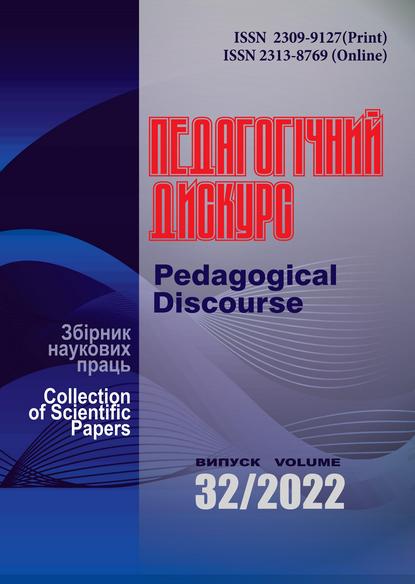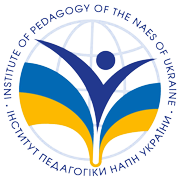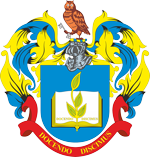Effective Ways to Maintain the Physical Performance of Students during Distance Learning
Abstract
The objective of the research was to test the effectiveness of the fitness program «WAY TO A HEALTHY LIFE». Indicators of morphofunctional and physical condition of students during quarantine restrictions were studied. The total number of respondents was 926 students (474 girls and 452 boys) from four higher education institutions in Ukraine. To implement the fitness program, the authors developed a model of physical education of students for the period of distance learning. To obtain the necessary information, we used general scientific research methods, namely: analysis of scientific and methodological sources, pedagogical modeling, pedagogical experiment, pedagogical observation, research methods of functional and physical condition of students, expert evaluation method, mathematical statistics methods, SWOT analysis. Five tests characterizing morphofunctional indicators were selected by the method of expert assessment (Stange test; Genchi test; body mass index; Ruffier-Dickson’s index; Harvard step test) and seven tests that characterize the indicators of physical development of students (exercises for arm strength; exercise for dexterity, exercise for speed; exercise for the development of abs; exercise for endurance, standing long-jump, Burpie’s test). The experimental research showed that out of five tests that characterize the level of development of morphofunctional signs of the body’s activity, the girls had improvement in four and the boys in three indicators. Other morphofunctional indicators remained at the previous level. Of the seven tests that characterize the level of development of different physical qualities, significant positive changes were observed in the performance of four exercises in girls and two exercises in boys, maintenance of the level of physical development occurred in the performance of two exercises in girls and four exercises in boys. Only the performance of endurance exercises in girls and boys showed negative dynamics. The SWOT-analysis showed the effectiveness of using the fitness program «WAY TO A HEALTHY LIFE» during distance learning.
Downloads
References
Zemtsova, I. I. (2008). Fiziolohiia sportu [Sports Physiology]. Kyiv: Olympic Literature. [in Ukrainian].
Kostenko, M., Dubovyk, R., & Otroshko, O. (2021). Zastosuvannia suchasnykh informatsiinykh tekhnolohii na urokakh fizychnoi kultury dlia uchniv v umovakh pandemii koronavirusu COVID-19. [Application of Modern Information Technologies in Physical Education Classes for Students in the Context of the COVID-19 Coronavirus Pandemic]. Naukovyi zhurnal Natsionalnoho Pedahohichnoho Universytetu imeni M. P. Drahomanova – Scientific journal of the National Pedagogical University named after M.P. Drahomanov, 81, 120–124. doi:10.31392/NPU-nc.series5.2021.81.25 [in Ukrainian].
Mozolev, O. M. (2022). Innovatsiini formy fizychnoho vykhovannia studentiv v period dystantsiinoho navchannia [Innovative Forms of Physical Education of Students in the Period of Distance Learning]. Hraal nauky – Grail of Science, 12–13, 676–683. doi:10.36074/grail-of-science.29.04.2022.123 [in Ukrainian].
Mozolev, O. M. (2022). Orhanizatsiia fizychnoho vykhovannia studentiv pedahohichnykh spetsialnostei [Organization of Physical Education of Students of Pedagogical Specialties]. Khmelnytskyi: FOP Tsiupak A. A. Retrieved from 212.111.198.18:88/jspui/handle/123456789/637 [in Ukrainian].
Serhiienko, V. M. (2014). Kontrol ta otsinka rukhovykh zdibnostei uchniv u protsesi fizychnoho vykhovannia [Control and Assessment of Motor Abilities of Students in the Process of Physical Education]. Sumy: SDU. [in Ukrainian].
Sysoieva, S., & Krystopchuk, T. (2013). Metodolohiia naukovo-pedahohichnykh doslidzhen. [Methodology of Scientific and Pedagogical Research]. Rivne: Volyn charms. [in Ukrainian].
Chekhovska, L. A. (2019). Ozdorovchyi fitnes u suchasnomu suspilstvi [Health Fitness in Modern Society]. Lviv: LDUFK. [in Ukrainian].
Chyzhyk, V., & Dudnyk, O. (2013). Metody doslidzhennia u fizychnomu vykhovanni [Research Methods in Physical Education]. Bila Tserkva. [in Ukrainian].
Aksay, E. (2021). Live online exercise programs during the Covid-19 pandemic – are they useful for elderly adults? Journal of Physical Education and Sport, 21 (4), 1650–1658. doi:10.7752/jpes.2021.04209 [in English].
Backman, E., & Barker, D. M. (2020). Re-thinking pedagogical content knowledge for physical education teachers – implications for physical education teacher education. Physical Education and Sport Pedagogy, 25, 451–463. [in English].
Chan, W. K., Leung, K. I., Ho, C. C., et al. (2021). Effectiveness of online teaching in physical education during COVID-19 school closures: a survey study of frontline physical education teachers in Hong Kong. Journal of Physical Education and Sport, 21, 1622–1627. doi:10.7752/jpes.2021.04205 [in English].
Cheval, B., Sivaramakrishnan, H., Maltagliati, S., et al. (2021). Relationships between changes in self-reported physical activity and sedentary behaviours and health during the coronavirus (COVID-19) pandemic in France and Switzerland. Journal of Sports Sciences, 39 (6), 699–704. [in English].
Chen, P., Mao, L., Nassis, G. P., Harmer, P., Ainsworth, B. E., & Li, F. (2020). Coronavirus disease (COVID-19): The need to maintain regular physical activity while taking precautions. Journal of Sport and Health Science, 9 (2), 103–104. doi:10.1016/j.jshs.2020.02.001 [in English].
Dakhin, A. N. (2002). Pedagogical modeling: essence, efficiency and uncertainty. Standards and Monitoring, 4, 21–26. [in English].
Ding, D., del Pozo Cruz, B., Green, M. A., & Bauman, A. E. (2020). Is the COVID-19 lockdown nudging people to be more active: a big data analysis. British Journal of Sports Medicine, 54, 1183–1184. doi:10.1136/bjsports-2020-102575 [in English].
Dominski, F. H., & Brandt, R. (2020). Do the benefits of exercise in indoor and outdoor environments during the COVID-19 pandemic outweigh the risks of infection? Sport Sciences for Health, 16, 583–588. doі: 10.1007/s11332-020-00673-z [in English].
Filiz, B., & Konukman, F. (2020). Teaching strategies for Physical Education during the COVID-19 pandemic, Journal of Physical Education Recreation & Dance, 91 (9). doi:10.1080/07303084.2020.1816099 [in English].
Griban, G., Skoruy, O., Pantielieiev, K., Brytan, Y., Tymchyk, M., Kharchenko, N., Skyrda, T., Halimov, A., Shorobura, I., & Mozolev, O. (2020). Influence of Physical Education Classes on the Level of Health and Fitness Competencies of Students. International Journal of Applied Exercise Physiology, 9 (12), 107–118. doi:10.26655/IJAEP.2020.12.1 [in English].
Griban, G., Nosko, M., Nosko, Yu., Zhlobo, T., Sirenko, R., Semeniv, B., Dikhtiarenko, Z., Zamrozevuch-Shadrina, S., Khatko, A., Rybchych, I., & Mozolev, O. (2021). Female Students’ Motor Skills Development by Means of Kangoo Jumps. International Journal of Human Movement and Sports Sciences, 9 (6), 1324–1343. doi:10.13189/saj.2021.090629 [in English].
Huber, B. C., Steffen, J., Schlichtiger, J. et al. (2020). Alteration of physical activity during COVID-19 pandemic lockdown in young adults. Journal of translation Medicine, 18, 410. doi:10.1186/s12967-020-02591-7 [in English].
Jiménez-Pavón, D., Carbonell-Baeza, A., & Lavie, CJ. (2020). Physical exercise as therapy to fight against the mental and physical consequences of COVID-19 quarantine: special focus in older people. Progress in Cardiovascular Diseases. doi:10.1016/j.pcad.2020.03.009 [in English].
Khmara, М., Mozolev, О., Yashchuk, І., Alieksieiev, О., Kravchuk, V., Dolynniy, Yu., Tomkiv, S., Binkovskyi, O., & Prontenko, V. (2021). Effectiveness of the Fitness Program «WAY TO A HEALTHY LIFE». International Journal of Human Movement and Sports Sciences, 9 (5), 833–840. doi:10.13189/saj.2021.090501 [in English].
Korwin-Szymanowska, A. (2017). When the environment has an impact: health awareness and social patterns as factors in physical activity of students. Forum Pedagogiczne, 2, 33–48. [in English].
Kozhokar, M., & Slobozhaninov, P. (2020). Means of wellness fitness during online physical education classes in higher education institutions during quarantine restrictions. Young Scientist, 11 (87), 231–233. doi:10.32839/2304-5809/2020-11-87-49 [in English].
Mozolev, О. (2018). Pedagogical Projecting of the Model of a Future Specialist. Pedagogical Discourse, 24, 82–87. doi:10.31475/ped.dys.2018.24.12 [in English].
Mozolev, O. (2021). Monitoring of the physical health state among 16-17-year-old female students. Baltic Journal of Health and Physical Activity, 13 (3), 47–54. doi:10.29359/BJHPA.13.3.06 [in English].
Mozolev, O., Chudyk, A., Miroshnichenko, V., Тushko, K., Kupchyshyna, V., Datskov, A., & Gorbenko, A. (2021). Formation of Physical Readiness of Cadets for Professional Activity under the Conditions of Quarantine. International Journal of Human Movement and Sports Sciences, 9 (5), 973–980. doi:10.13189/saj.2021.090519 [in English].
Mozolev, O., Kravchuk, L., Ostrovska, N., Nahorna, О., Polishchuk, О., & Khmara, М. (2020). Checking the effectiveness of the method of conducting physical education classes with 17-19-year-old female students of special medical group. Journal of Physical Education and Sport, 20 (2), 870–876 doi:10.7752/jpes.2020.02124 [in English].
Mozolev, O., Polishchuk, O., Kravchuk, L, Tatarin, О., Zharovska, О., & Kazymir, V. (2020). Results of monitoring the physical health of female students in the context of the COVID-19 pandemic. Journal of Physical Education and Sport, 20 (6), 3280–3287. doi:10.7752/jpes.2020.s6445 [in English].
Mozolev, O., Polishchuk, O., Shorobura, I., Miroshnichenko, V., Тushko, K., Voloshyn, V., Tomkiv, I., & Binkovskyi, O. (2021). Motor Activity and Physical Abilities of Students in the Conditions of Restrictions of COVID-19. International Journal of Human Movement and Sports Sciences, 9 (3), 428–435. doi:10.13189/saj.2021.090306 [in English].
Nyenhuis, S. M, Greiwe, J., Zeiger, J. S., et al. (2020). Exercise and fitness in the age of social distancing during the COVID-19 pandemic. The Journal of Allergy and Clinical Immunology: in Practice, 8 (7), 2152–2155. [in English].
O’Brien, W., Adamakis, M., O’Brien, N., Onofre, M., Martins, J., Dania, A., et al. (2020). Implications for European Physical Education Teacher Education during the COVID-19 pandemic: a crossinstitutional SWOT analysis. European Journal of Teacher Education, 43, 503–522. [in English].
Osipov, A., Ratmanskaya, T., Zemba, E., Potop, V., Kudryavtsev, M., & Nagovitsyn, R. (2021). The impact of the universities closure on physical activity and academic performance in physical education in university students during the COVID-19 pandemic. Physical education of students, 25 (1), 20–27. doi:10.15561/20755279.2021.0103 [in English].
Rasheed, А., Abduljawad, R., Mabrouk, S., Jdaitawi, M., & Abdulmonem, M. (2021). Physical Fitness Training Program Using Electronic Simulation Games to Foster Psychological Health among University Students during COVID-19 Pandemic. International Journal of Human Movement and Sports Sciences, 9 (3), 421–427. doi:10.13189/saj.2021.090305 [in English].
Sfyri, Е., Tertipi, N., Kefala, V., Biskanaki, F., Andreou, E., & Rallis, T. (2021). Paradoxical increase in frequency of physical activity behavior during SARSCov-2 restriction measures in a Greek university community. Journal of Physical Education and Sport, 21 (4), 1814–1821. doi:10.7752/jpes.2021.04229 [in English].
Sharkey, В., & Gaskill, S. (2013). Fitness & health. Human Kinetics. [in English].
Singh, V., Acharya, J., & Bhutia, T. (2021). Effect of 6 weeks of online vinyasa training on explosive leg strength of school children during COVID-19 – A pilot study. Journal of Physical Education and Sport, 21, 2276–2282. doi:10.7752/jpes.2021.s4304 [in English].
Susilo, Tirto Apriyanto, Hernawan, et al. (2021). Impact of brain breaks to supporting the physical activity during the Covid-19 Pandemic in elementary school. Journal of Physical Education and Sport, 21, 2312–2317. doі:10.7752/jpes.2021.s4309 [in English].
Webster, C.A., D’Agostino, E., Urtel, M., McMullen, J., Culp, B., Loiacono, C.A.E., & Killian, C. (2021). Physical Education in the COVID Era: Considerations for Online Program Delivery Using the Comprehensive School Physical Activity Program Framework. Journal of Teaching in Physical Education, 40, 327–336. [in English].
Woods, J. A. et al. (2020). The COVID-19 pandemic and physical activity. Sports, Medicine and Helath Science, 2 (2), 55–64. doi:10.1016/j.smhs.2020.05.006 [in English].
Zhamardiy, V., Shkola, O., Okhrimenko, I., Strelchenko, O., Aloshyna, A., Opanasiuk, F., Griban, G., Yahodzinskyi, V., Mozolev, O., & Prontenko, K. (2020). Checking of the methodical system efficiency of fitness technologies application in students’ physical education. Wiadomości Lekarskie, 73 (2), 332–341. doi: 10.36740/WLek202002125
Copyright (c) 2022 Pedagogical Discourse

This work is licensed under a Creative Commons Attribution-NonCommercial-ShareAlike 4.0 International License.

















